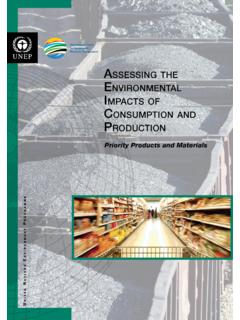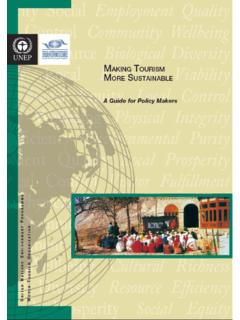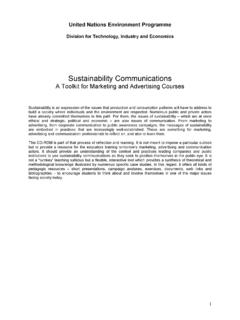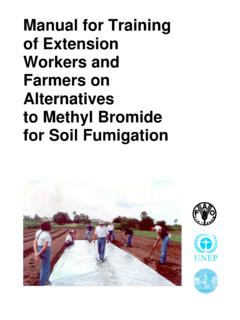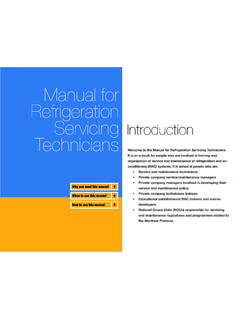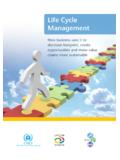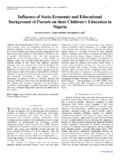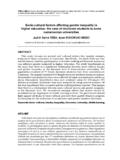Transcription of GUIDELINES FOR SOCIAL LIFE CYCLE ASSESSMENT …
1 UNITEDNATIONSENVIRONMENT PROGRAMMEGUIDELINES FORSOCIALLIFECYCLEASSESSMENTOF PRODUCTSB elgian Federal Public Planning ServiceSustainable DevelopmentCopyright United Nations Environment Programme, 2009 This publication may be reproduced in whole or in part and in any form for educational or non-profit purposes without special permission from the copyright holder, provided acknowledgement of the source is made. UNEP would appreciate receiving a copy of any publication that uses this publication as a use of this publication may be made for resale or for any other commercial purpose whatsoever without prior permission in writing from the United Nations Environment designations employed and the presentation of the material in this publication do not imply the expression of any opinion whatsoever on the part of the United Nations Environment Programme concerning the legal status of any country, territory, city or area or of its authorities, or concerning delimitation of its frontiers or boundaries.
2 Moreover, the views expressed do not necessarily represent the decision or the stated policy of the United Nations Environment Programme or any participants such as members of the International life CYCLE Board, nor does citing of trade names or commercial processes constitute contained herein does not necessarily reflect the policy or views of the Society of Environmental Toxicology and Chemistry (SETAC). Mention of commercial or noncommercial products and services does not imply endorsement or affiliation by : 978-92-807-3021-0 DTI/1164/PAUNEP promotesenvironmentally sound practices globally and in its own activities. This publication is printed on Cyclusprint paper (100% post-consumer fibres, Blue Angel certified) using vegetable based ink (no mineral oils, no volatile organic solvent, no isopropylalcohol).Our distribution policy aims to reduce UNEP s carbon footprint. GUIDELINES for SOCIAL life CYCLE ASSESSMENT of ProductsSocial and socio - economic LCA GUIDELINES complementing environmental LCA and life CYCLE Costing, contributing to the full ASSESSMENT of goods and services within the context of sustainable developmentAcknowledgmentsProducerThis Guide has been produced by the UNEP/SETAC life CYCLE Initiative at UNEP, CIRAIG, FAQDD and the Belgium Federal Public Planning Service Sustainable Development.
3 EditorCatherine Beno t, UQAM/CIRAIG, and Bernard Mazijn, Ghent University Supervision,Technical editing and supportSonia Valdivia, Guido Sonnemann and Bas de Leeuw, UNEP DTIEC hair and Co-chairs of the Project GroupBernard Mazijn, Belgium, Andr e-Lise M thot, Canada, Bo Weidema, Denmark AuthorsAndrews, Evan Stuart, SylvaticaBarthel, Leif-Patrick, LBP-Universit t StuttgartBeck Tabea, LBP-Universit t StuttgartBeno t, Catherine, UQAM/CIRAIG, SylvaticaCiroth, Andreas, GreenDeltaTCCucuzzella, Carmela, UDM, LEAP/CIRAIGG ensch, Carl-Otto, Oeko InstituteH bert, Julie, Fonds d Investissement en D veloppement DurableLesage, Pascal, Sylvatica/CIRAIGM anhart, Andreas, Oeko InstituteMazeau, Pierre, Electricit de FranceMazijn, Bernard, Ghent UniversityMethot, Andr e-Lise, CYCLE Capital ManagementMoberg, Asa, KTH, Royal Institute of TechnologyNorris, Greg, Harvard, SylvaticaParent, Julie, UQAM/CIRAIGP rakash, Siddarth, Oeko Institute Reveret, Jean-Pierre, UQAM /CIRAIG Spillemaeckers, Sophie, HIVA, University of Leuven Ugaya, Cassia Maria Lie.
4 UTFPR, ItapicuruValdivia, Sonia, UNEP DTIEW eidema, Bo, Ecoinvent, LCA consultantsInternational scientific and professional reviewers panel Althaus, Hans-Joerg, EMPAA rena, Alejandro Pablo, Unidad de Postgrado, Facultad UTNB ouamrane, Meriem, UNESCO MABB uonamici, Roberto, ENEAB uttol, Patrizia, ENEAC lark, Garrette E, UNEP DTIEF inkbeiner, Mathias, TU Berlin Fraisse, Henri, TOTAL, Raffinage Marketing DDMasoni, Paolo, ENEAM ozur, Michael, SETACP oschen, Peter, International Labor OfficeTrudel, Jean-S bastien, ellipsosVan der Lugt, Cornelis, UNEP DTIEVon Geibler, Justus, Wuppertal InstituteWaldron, David, David Suzuki Foundation and Synapse Strategies White, Philip, Arizona State University Zamagni, Alessandra, ENEAT hanks to the international stakeholders organizations who participated in the consultation process Accountability International (AI)Consumers International (CI)Fair Labor Association (FLA) Fair Trade Advocacy Office (FTAO)International Consumer Research & Testing Ltd (ICRT)International Labour Office (ILO)International Organization of Employers (IOE) International SOCIAL and Environmental Accreditation and Labelling Alliance (ISEAL)International Trade Union Confederation (ITUC)Society of Environmental Toxicology and Chemistry (SETAC) United Nations Environment Programme (UNEP)US International Bureau of Labor Affairs (ILAB)World Business Council for Sustainable Development (WBCSD)Design and lay-outNatasha Genest and M lina Patry, Corsaire designPrintingDruk in de weer, BelgiumPhotographyThanks to Sylvia Ferratini, Catherine Beno t, and UNEP for their picture contributions.
5 Thanks also to Still pictures and IStockphoto from whom many pictures were authors would like to thank everybody who has contributed to these GUIDELINES providing valuable background, ideas, comments, especially the stakeholders involved through interactions listed in annex 1B and the participants in the two consultations held in Qu bec. The authors would especially like to thank Gage Norris for the General Public Summary writing, Shannon Rogers (University of New Hampshire) and Tatiana de Feraudy (UNEP) for the professional English review. The development of these GUIDELINES was sponsored by grants from the Fonds d Action Qu b cois pour le D veloppement Durable (FAQDD) and from the SOCIAL Sciences and Humanities Research Council (SSHRC) attributed to University of Quebec in Montreal (UQAM) by the Interuniversity Research Centre for the life CYCLE ASSESSMENT of Products, Processes and Services (CIRAIG)
6 , the Ecole Polytechnique of Montr al s International Chair in life CYCLE ASSESSMENT , the Belgium Federal Public Planning Service Sustainable Development, UNEP, SETAC and CYCLE Capital for SOCIAL life CYCLE ASSESSMENT of ProductsExecutive summaryTheGuidelines for SOCIAL life CYCLE ASSESSMENT of Products provides a map, a skeleton and a flash light for stakeholders engaging in the ASSESSMENT of SOCIAL and socio - economic impacts of products life , the S-LCA GUIDELINES provides a map, which describes the context, the key concepts, the broader field in which tools and techniques are getting developed and their scope of application. The map is important because it relates to history, initiatives and ideas that are both molding the S-LCA technique and essential to its broad concerns about the state and sustainability of environmental, economic and SOCIAL dimensions of today s and tomorrow s world are expressed through the concept of Sustainable Development.
7 The journey towards sustainability finds sustainable production and consumption at its very heart. It also relates to the SOCIAL responsibility of organizations and the objective to improve SOCIAL and environmental performances along with sustained economic profitability -all in the perspective to contribute notably to greater human it is holistic, systemic and rigorous, life CYCLE ASSESSMENT is the preferred tool when it comes to access information about potential and real impacts of products life CYCLE . life cycles of products involve material, energy and economic flows. They are also made of stories about production and consumption impacts on the workers, the local communities, the consumers, the society and all value chain actors. Second, the S-LCA GUIDELINES provides a skeleton. It presents key elements to consider and provide guidance for the goal and scope, inventory, impact ASSESSMENT and interpretation phases of a SOCIAL life CYCLE ASSESSMENT .
8 The S-LCA GUIDELINES provide the necessary basis for the development of databases and the design of softwares that will ease the practice of S-LCA. The skeleton is important because it is a foundation on which a larger group of stakeholders can framework detailed in the S-LCA GUIDELINES is in line with the ISO 14040 and 14044 standards for life CYCLE ASSESSMENT . Adaptations for the consideration of SOCIAL and socio - economic issues are described in the framework. It proposes a two-fold classification of SOCIAL impacts: by stakeholder categories and impact categories. A set of subcategories, which are SOCIAL and socio - economic issues of concerns, to be used in S-LCA are , the S-LCA GUIDELINES provide a flash light that highlights areas where further research is needed. Other publications shall follow these GUIDELINES , presenting details of the methodology and further developments notably in regard to Impact ASSESSMENT . A flash light is important to enable researchers and practitioners to identify rapidly where additional efforts should be invested.
9 It also helps to prevent the use of the technique for applications that would not be appropriate considering its current state of development such as comparative assertion communicated to the public. Further resources will be made available to the public on the UNEP/SETAC life CYCLE Initiative web site. SOCIAL life CYCLE ASSESSMENT is a technique available to account for stories and inform systematically on impacts that otherwise would be lost in the vast and fast moving sea of our modern world. May it help stakeholders to effectively and efficiently engage to improve SOCIAL and socio - economic conditions of production and for SOCIAL life CYCLE ASSESSMENT of ProductsSommaire ex cutifLesLignes directrices pour l Analyse sociale du CYCLE de vie des produits (ASCV) fournissent une carte, un squelette et une lampe de poche pour les parties prenantes qui s engagent dans l valuation des impacts sociaux et socio - conomiques du CYCLE de vie des produits.
10 Premi rement, les Lignes directrices pour l ASCV d livrent une carte qui d crit le contexte, les concepts- cl s et le champ dans lequel les outils et techniques ont t d velopp s, et pr sentent leurs applications possibles. Cette carte est importante car elle retrace l histoire, les initiatives et les id es qui ont fa onn l ASCV. La compr hension de ces composantes est essentielle pour mettre en oeuvre cette technique de mani re coh rente et extensive. Les pr occupations communes concernant l tat et la durabilit des dimensions environnementale, conomique et sociale du monde d aujourd hui et de demain sont exprim es dans le concept de d veloppement durable. La production et la consommation durables sont au c ur de ce concept. Il se rapporte galement la responsabilit sociale des organisations et vise am liorer les performances sociales et environnementales l instar de la rentabilit conomique long terme dans la perspective de contribuer notamment un plus grand bien- tre humain.
